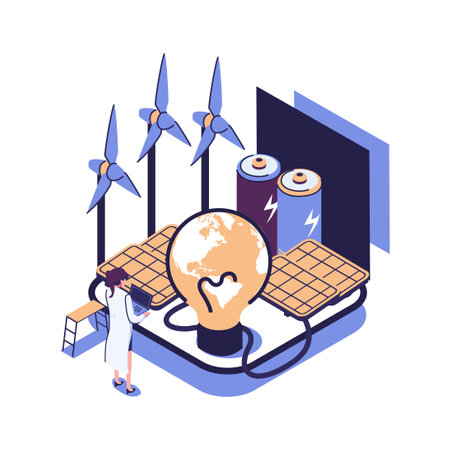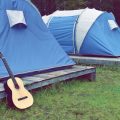1. Why Go Solar? The Perks of Off-Grid Power
Camping has always been about getting away from it all, but that doesnt mean you have to completely unplug. With solar power, you can enjoy the beauty of nature while still having access to some modern comforts. Whether youre deep in a national park or parked at a remote boondocking site, solar energy gives you the freedom to explore off-grid without sacrificing convenience.
Freedom and Flexibility
Solar-powered camping lets you go further and stay longer. You don’t need to worry about finding electrical hookups or running out of generator fuel. Once your solar panels are set up, you’re harnessing free energy straight from the sun—no noise, no fumes, and no ongoing costs.
Eco-Friendly Adventure
One of the biggest perks of using solar energy is reducing your carbon footprint. Traditional generators burn fossil fuels and emit harmful gases, but solar panels produce clean, renewable energy. It’s a great way to respect the environment while enjoying it.
Save Money Over Time
While the initial investment in solar gear might seem high, it pays off in the long run. No more spending on propane or gas for a generator, and some public lands even charge less for campers using eco-friendly setups.
Quiet and Low Maintenance
Generators can be loud and disruptive—not just to you, but to other campers and wildlife. Solar panels work silently and require very little maintenance once installed properly.
Comparison: Solar Power vs. Traditional Generator
| Feature | Solar Power | Gas Generator |
|---|---|---|
| Noise Level | Silent | Loud |
| Fuel Source | Sunlight (free) | Gasoline/Propane (paid) |
| Maintenance | Low | Moderate to High |
| Environmental Impact | Minimal | High (emissions) |
| Setup Cost | Moderate to High (one-time) | Lower initially |
The Bottom Line
If youre looking to camp smarter—not harder—solar power is a game changer. It’s ideal for RVers, van lifers, or tent campers who want more independence and a greener way to travel. In the next section, we’ll dive into what gear you need to get started with solar-powered camping.
2. Essential Solar Gear for Campers
When it comes to solar-powered camping, having the right gear can make all the difference between a frustrating trip and an enjoyable off-grid experience. Below is a breakdown of must-have solar gear that every camper should consider packing for their next adventure.
Portable Solar Panels
Portable solar panels are the backbone of any solar-powered setup. They convert sunlight into electricity and can be used to charge devices directly or store energy in a battery bank.
Things to Consider:
- Wattage: Higher wattage means faster charging.
- Portability: Look for foldable or roll-up designs for easy transport.
- Compatibility: Make sure it works with your devices or power stations.
Solar Generators (Power Stations)
A solar generator stores energy collected from solar panels and lets you power larger devices like mini-fridges, CPAP machines, laptops, or even small appliances.
Popular Features:
- Multiple Output Ports: USB, AC, and DC outputs offer flexible charging options.
- Battery Capacity: Measured in watt-hours (Wh) — more capacity equals longer usage time.
- Recharge Options: Solar, wall outlet, and car charger inputs add versatility.
Battery Banks
If you don’t need a full-sized power station, a compact battery bank might be all you need to keep phones, cameras, and headlamps charged during your trip.
| Battery Bank Type | Ideal For | Average Capacity (mAh) |
|---|---|---|
| Pocket-size | Phones & small gadgets | 5,000–10,000 |
| Mid-range | Tablets & multiple devices | 10,000–20,000 |
| High-capacity solar banks | Laptops & extended use | 20,000+ |
Solar Lighting Systems
No one wants to fumble around in the dark at camp. Solar lighting options are lightweight and recharge during the day to provide hours of illumination at night.
Types of Solar Lights:
- Lanterns: Great for lighting up tents or picnic tables.
- String Lights: Add ambiance and visibility around camp areas.
- Headlamps & Flashlights: Essential for hiking or late-night bathroom trips.
Pro Tip:
Select lights with built-in USB ports so they can double as emergency phone chargers!
Packing the right solar gear not only keeps your devices powered but also enhances safety and comfort while youre off the grid. Always match your gear choices with your specific camping needs to get the most out of your outdoor experience.

3. How to Choose the Right Solar Setup
Choosing the right solar setup for your camping adventures doesn’t have to be complicated. Whether youre glamping in a fully equipped RV or backpacking deep into the wilderness, your power needs and gear should match your style of camping. Heres how to figure out what works best for you.
Know Your Power Needs
The first step is figuring out how much power youll actually need. Make a list of all the devices you plan to bring, like smartphones, tablets, GPS units, headlamps, portable fridges, or even CPAP machines. Then check how many watts each device uses and estimate how long youll use them each day.
Common Device Power Usage (Approximate)
| Device | Watts per Hour | Daily Use (Hours) | Total Daily Watt-Hours |
|---|---|---|---|
| Smartphone | 5W | 2 hrs | 10 Wh |
| LED Lantern | 10W | 4 hrs | 40 Wh |
| Laptop | 60W | 2 hrs | 120 Wh |
| Portable Fridge | 45W | 24 hrs (intermittent) | 250 Wh* |
*Actual usage may vary based on outside temperature and insulation.
Selecting Gear for Your Camping Style
If Youre Glamping or RV Camping:
- Larger Solar Panels: Opt for rigid or foldable panels with high wattage (100W+).
- Power Station or Battery Bank: Choose one with AC outlets and enough capacity (500Wh–2000Wh) to run small appliances.
- Permanent Installations: Consider roof-mounted panels if you camp often in sunny areas.
- Charge Controllers & Inverters: These help regulate power flow and convert energy efficiently for household devices.
If You’re Tent Camping or Car Camping:
- Portable Solar Panels: Lightweight and foldable panels around 50–100W work well.
- Mid-Sized Power Stations: Look for options between 300Wh–600Wh that can charge phones, lights, and small fans.
- Solar Chargers: Compact USB solar chargers are great backups for phones and headlamps.
If You’re Backpacking Off the Grid:
- Ultralight Solar Chargers: Small, foldable panels under 30W that attach to your pack are perfect for hikers.
- Power Banks: Pre-charge before your trip; look for rugged models with at least 10,000mAh capacity.
- No-Frills Setup: Stick to essentials like charging your phone or GPS—save weight by skipping larger gear.
Solar Panel Types: Which One’s Right for You?
| Type | Description | Best For |
|---|---|---|
| Rigid Panels | Tough and efficient, but heavier and bulkier. | RV setups or stationary campsites |
| Foldable Panels | Lighter and portable; easy to pack and unfold at camp. | Tent camping or car camping |
| Semi-Flexible Panels | Bendable; can be mounted on curved surfaces like vehicle roofs. | Crossover builds or roof mounting on vans/RVs |
| Pocket-sized Chargers | Tiny panels that charge small devices directly via USB. | Backpacking or emergency use only |
A Few Quick Tips Before You Buy:
- Add up total daily watt-hours needed, then choose a solar system that generates at least 20–30% more (to account for cloudy days). 4. Solar Charging Tips and Techniques
- Charge During Peak Sun Hours: The best time to charge is between 10 AM and 4 PM when sunlight is strongest.
- Use Power Banks: Charge a power bank during the day, then use it to recharge your phone or other electronics at night.
- Prioritize Essential Devices: Start by charging must-haves like phones, GPS units, or lanterns before less critical items.
- Avoid Charging Directly to Devices: Some solar panels can have inconsistent output; using a power bank helps prevent damage to sensitive electronics.
- Pick an Open Area: Avoid shaded spots under trees or cliffs that block sunlight.
- Angle Your Panels Correctly: Tilt them towards the sun—about 45° is a good rule of thumb for most U.S. latitudes.
- Track the Sun: Move your panels throughout the day to follow the sun’s path for optimal exposure.
- Avoid Obstructions: Keep panels clean and free from dust, leaves, or bird droppings that can reduce efficiency.
- Turning off any inverter fans at night if theyre loud
- Avoiding flashing indicator lights after dark—cover them if needed
- Keeping gear within your designated campsite boundaries
- Use weatherproof cases for batteries and controllers
- Elevate panels slightly off the ground to prevent water pooling underneath
- Pack away gear during storms or high winds to avoid damage or loss
- Cable wrap wires in protective tubing to deter animals from chewing them
- Campsite Respect: Keep everything within your space and out of the way.
- No Hazards: Secure cables and devices properly.
- Stay Stealthy: Minimize noise and light pollution.
- Weather-Ready: Monitor forecasts and pack down when needed.
- Critter-Proof: Protect wires and store food separately from gear.
When youre out in the wild relying on solar power, knowing how to charge your devices efficiently can make or break your camping experience. Here are some simple, effective tips to help you get the most out of your solar gear while camping.
Best Practices for Charging Devices Efficiently
Getting a full charge from the sun takes more than just plugging in your device. Here’s how to do it right:
Understanding Weather Impact on Solar Performance
The weather plays a huge role in how much energy your solar setup can collect. Heres how different conditions affect performance:
| Weather Condition | Solar Efficiency | Tips |
|---|---|---|
| Sunny & Clear | 100% | Ideal charging conditions—maximize use during these hours. |
| Partly Cloudy | 50-80% | Adjust panel angle frequently as sun shifts through clouds. |
| Overcast | 10-30% | Use high-efficiency panels and consider supplemental battery storage. |
| Rainy | <10% | Avoid charging; protect gear from moisture and rely on stored energy. |
Maximizing Sun Exposure at Campsites
Your campsites location and layout directly affect how well your solar panels perform. Use these tips to soak up every ray:
Bonus Tip: Use a Solar Charger with a Built-In Stand
This makes positioning easier and saves you from propping it up with rocks or logs. Some even come with sun-tracking features!
Your Solar Setup Is Only as Good as Its Placement
No matter how fancy your gear is, if its sitting in the shade, its not doing much. Take time each morning to set things up right—it’ll pay off when the sun goes down and your batteries are still going strong.
5. Campground Etiquette and Safety with Solar Gear
Using solar power while camping is a smart and eco-friendly choice, but it’s important to be mindful of your fellow campers and the natural surroundings. Setting up your solar gear responsibly ensures a smooth experience for you and those around you. Here are some key guidelines to follow when using solar equipment at a campground.
Setting Up Your Solar Equipment Responsibly
Placement matters when setting up your solar panels. Try to position them in an area that gets maximum sunlight but doesn’t block pathways or intrude into neighboring campsites. Always secure cables to prevent tripping hazards and avoid placing gear in communal areas like picnic tables or shared fire pits.
Tips for Smart Solar Setup:
| Do | Dont |
|---|---|
| Place panels where they get full sun, like on top of your RV or tent roof | Lay panels in walkways or near high-traffic areas |
| Use cable organizers or tape to secure loose wires | Let cords snake across common areas |
| Inform neighbors if your setup might affect their space | Assume everyone is okay with your gear being spread out |
Minimizing Disturbances to Fellow Campers
Your solar setup shouldn’t interfere with the peace and quiet others came to enjoy. Avoid noisy generators (even solar ones with fans), bright LED lights at night, or reflective surfaces that could bother nearby campers. Keep your gear tidy and compact when not in use.
Be Considerate By:
Protecting Your Gear from Wildlife and Weather
Your solar equipment is an investment, so keeping it safe from both curious critters and sudden weather changes is key. Wildlife like raccoons or squirrels may chew on wires, while unexpected rain or wind can damage unprotected setups.
Protection Tips:
Quick Checklist for Safe Solar Camping:
By following these simple guidelines, you’ll not only have a safer camping experience with your solar gear, but you’ll also keep the vibe friendly for everyone else enjoying the great outdoors.


